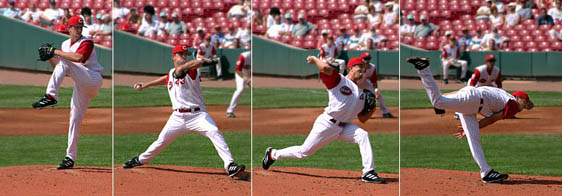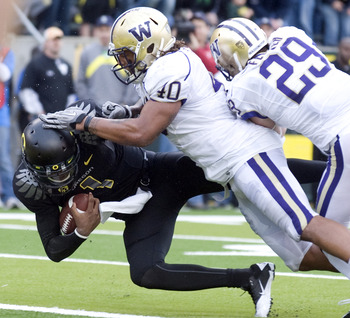How training eccentrically makes you more explosive
What separates the good athletes from the great athletes? The ability to accelerate and decelerate quickly. Today, we are going to look at how the body handles deceleration, and how we can train it more efficiently.
You may not realize it, but producing and controlling movement is a pretty complicated process. Take for example world recorder holder in the 100 and 200m, Usain Bolt. His average speed during a race is around 23 mph, which translates into around 34 feet per second. Let those numbers roll around in your brain again – 34 feet per second! That’s incredibly fast. Now think about what it takes to decelerate a human body flying (because he’s closer to flying than running) through the air at that speed. The key to decelerating after a sprint or after a jump is eccentric contraction, or the lengthening of a muscle. Concentric contractions occur when muscles shorten to produce movement, which we will talk about in the next post. But so you have a visual, think about an athlete performing a vertical jump test. The athlete starts standing upright, then performs a slight downward movement (the eccentric action), and then explodes up as high as possible (concentric action). This is called the stretch shortening cycle (SSC).
1.) Eccentric - muscles are actively lengthened
2.) Amortization - the stretched components of the muscle/tendon store energy
3.) Concentric – muscles are shortened and force is produced
Why do we care about this at all? Well first of all, the storage and recovery of the energy between eccentric and concentric muscle action is what causes a movement to be either powerful/explosive, or slow/weak. The energy is stored in tendons and collagen, but also in the muscle. The goal is to fine-tune the muscles/tendons to efficiently store and recover energy during movements. Now think about all movements done in sport that are explosive or powerful in nature. Sprinting, jumping, spiking a volleyball, throwing a baseball, swinging a golf club. In all of these actions, there is a distinct eccentric, amortization, and concentric phase. Let's take a look at eccentric training:
1.) Training eccentrically makes you more explosive:
Take for example throwing a baseball/softball. There are several eccentric contractions taking place in both upper and lower body before powerful concentric actions can take place.

Windup, cocking, late cocking phase = eccentric lengthening
Internal rotators of shoulder = eccentric lengthening
As the arm comes through, the hips rotate, and the ball is thrown, the action goes from eccentric to concentric. It is obvious from looking at seasoned baseball/softball players that some sort of adaptations are taking place. You will see greater external rotation in the throwing arm when compared to the non-throwing arm. Why is that? Because muscle fibers acutely adapt to eccentric exercise and change optimal length. The addition of sarcomeres allows the muscle fibers to effectively operate at longer lengths (LaStayo et al). If the magnitude of the force during eccentric action can be maximized, then the result is a more powerful concentric phase = faster first step, higher jump, faster arm action…
2.) Training eccentrically prevents injury
Let’s look at the example of downhill running or hiking. Walking downhill involves eccentric lengthening of muscle fibers the whole time. Let’s look at a quick real life story. Bobby and I took a trip to Yosemite a few weeks ago and hiked half dome. Bobby was wearing a back pack easily twice as heavy as mine for the 16 mile hike. On the way up, I was full of energy and paces ahead of Bobby. On the way down, my legs were screaming at me and left me sore for 5 or 6 days after. All that eccentric lengthening caused some major delayed onset muscle soreness (DOMS) to me, but not to Bobby because he had just done a brutal hike a few weeks prior. Research has shown that the chronic use of eccentric contractions results in a protective adaptation in the muscle called the repeated-bout effect. Basically, integrating eccentric training into your program causes your muscles to adapt and protect themselves from damage. Eccentric resistance training can lead to increased stiffness in tendons, greater force at failure, and an improved ability to absorb energy at the junction between muscles and tendons (LaStayo et al). These are some sweet adaptations for athletes; however, the negative part is that eccentric training causes soreness. In a later blog post, we will look at ways to guard from soreness.
Furthermore, it seems many professional football players have been plagued by hamstring strains lately. Research has shown that athletes who have recurring hamstring strains tend to have greater concentric then eccentric strength, which is opposite of what is recommended.

The only way to combat this is to increase strength in the hamstrings through eccentric exercises. In fact, 2-3x greater force can be produced eccentrically then concentrically. This is because it has the ability to overload the muscle to a greater extent, thus increasing muscle mass, strength and power. But how many athletes or people in the gym do you see training their posterior side and their hamstrings? You see people training the “mirror muscles” – or only the front side of your body. This could be why we see so many hamstring issues these days.
3.) Just start training already!
Athletes need to be efficient at decelerating. The primary muscle group used for deceleration is the hamstrings, so we need to choose hamstring dominant exercises. We also need to consider that most movements occur on just a single leg, which is why single leg exercises could prove to be more beneficial than bilateral execises. Plyometrics are a great way to train deceleration. In fact, back in the 1970’s, Russians used to dominate the sprinting scene. The Russian’s secret? They incorporated drop jumps and depth jumps into their training. A drop jump is simply stepping off a box and sticking the landing, where as a depth jump is stepping of a box, landing on the ground and immediately jumping up as high as possible. Athletes also need to incorporate hamstring-specific lifts into their workouts. RDL’s (Romanian deadlifts) are one example of a hamstring-specific exercise, but there are many variations to them. Here is Kristina (former Notre Dame softball player) showing a few ways to make single leg RDL’s harder.
Here is another clip of her showing how to progress a hip lift. The last part of the video shows her doing a modified hip thrust. Remember, youth athletes need to progress slowly and may not be moving significant amounts of weight at first. It’s important to get creative with the equipment you have and figure out things that work for the athletes.
And finally, here’s Kristina showing a Split squat (rear foot elevated). The only reason she is using a Bosu is because it happens to be a good height for some younger athletes. A bench is usually an ideal height for older athletes, but shorter athletes may need something a few inches lower.
These are not the only hamstring dominant exercises you can do, but they will give you a good start on training eccentrically. Remember, eccentric actions are commonly the source of injury in athletes of all ages. However, training eccentrically in a controlled setting can cause muscle/tendon adaptations to occur that will help to not only protect from injury, but also increase sport performance.
References
Cowell, J., Cronin, J., Brughelli, M. (2012). Eccentric muscle actions and how the strength and conditioning specialist might use them for a variety of purposes. Strength and Conditioning Journal. 34:3
LaStayo, P., Woolf, J., Lewek, M., Snyder-Mackler, L., Reich, T., Lindstedt, S. (2003). Eccentric muscle contractions: their contribution to injury, prevention, rehabilitation, and sport. Journal of Orthopedic Sports Physical Therapy. 33: 557-571.

